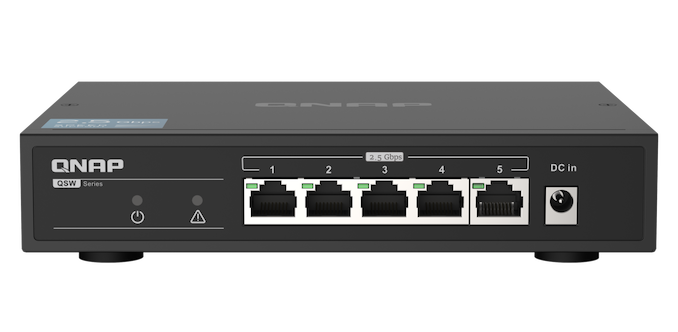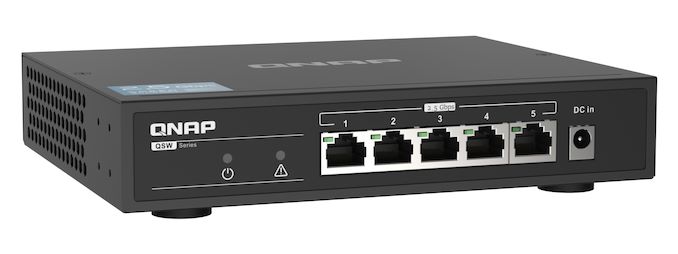At Last, a 2.5Gbps Consumer Network Switch: QNAP Releases QSW-1105-5T 5-Port Switch
by Ryan Smith on July 17, 2020 11:30 AM EST- Posted in
- Networking
- QNAP
- NBASE-T
- 2.5GBase-T
- Ethernet
- 2.5 GbE

After entirely too long of a delay, the wait for faster consumer-grade network switches appears to be coming to an end. This week QNAP launched its QSW-1105-5T switch, one of the industry’s first unmanaged 2.5Gbps (2.5GBASE-T) switches. The 5-port switch supports 2.5GbE operation on all five of its RJ45 Ethernet ports, and along with being unmanaged it is also fanless, allowing the switch to work maintenance-free and installed virtually anywhere. The QSW-1105-5T is already on sale in Taiwan for roughly $100, meaning that we’re looking at a price-per-port of about $20.
The saga of NBASE-T has been something of a long one. First introduced in 2016, the standard added the then-new 2.5GBASE-T and 5GBASE-T modes, which were designed to offer a series of intermediate steps between the existing 1Gbps (1000BASE-T) and 10Gbps (10GBASE-T) standards. By scaling down parts of the 10GBASE-T spec, the new standards would allow more modest – but still many times faster – network transmission rates than 1Gbps Ethernet, all the while being able to reuse existing Cat5e and Cat6 cabling. Overall, 2.5GBASE-T allows for 2.5Gbps Ethernet over Cat5e at the same 100m distances as 1Gbps Ethernet, while 5GBASE-T allows for 5Gbps speeds over 100m runs of Cat6, as well as quasi-official support for shorter Cat5e runs.
Given the technology reuse, moderately-priced NBASE-T network cards were quick to hit the market. However affordable switches have been a more complex matter: while the high initial price of NBASE-T was easy enough to eat on a single controller, multiplied over several ports on a switch, it quickly drove up the price tag. As a result, the market for NBASE-T switches has largely between split between downgraded pro gear like Netgear’s $70-per-port XS505M, and mixed-port switches like Asus’s XG-U2008, which offer just two 10G/NBASE-T ports along with a slew of Gigabit Ethernet ports. So cheap NBASE-T networking options have remained elusive, at least until now.
Thankfully, in the last year we’ve finally started seeing the slower of the NBASE-T modes, 2.5GBASE-T, sprint towards wide adoption. The 2.5Gbps standard is the cheapest to implement, and with recent controller releases from the likes of RealTek and Intel, 2.5Gbps controllers have quickly become a staple on high-end motherboards. Accordingly, with the price per port coming down for 2.5Gbps controllers, it’s also bringing down the price of whole switches. And this is where QNAP’s new switch comes in.
The QSW-1105-5T is one of the first switches to be released using these new generations of cheap controllers. Aimed squarely at the home and SMB markets, the switch doesn’t offer any frills such as network management, Power over Ethernet, or SFP+ ports. Instead it focuses on the things that matter for the home market: supporting 2.5Gbps networking in a small, passively-cooled switch that’s suitable to be neglected by being tucked under a desk or in a closet.
| QNAP QSW-1105-5T Switch | |
| Speeds | 100M/1G/2.5G |
| Ports (RJ45) | 5 |
| Managed | No |
| Power | 12 W |
| Dimensions | 3.4 x 18 x 14.5 cm |
| Cooling | Passive (Fanless) |
| Price | ~$100 |
As the first of what will undoubtedly be many 2.5G switches over the coming months, the QSW-1105-5T also gives us our first real look at what we can expect from this generation of switches as far as footprints and power consumption goes. Since it’s not carved from a pro-grade switch, the 18 cm x 14.5 cm switch is significantly smaller than earlier NBASE-T switches. And with a maximum power consumption rating of 12 W, we’re looking at power consumption of just a bit over 2 Watts per port, which is also a significant improvement over admittedly far more powerful switches.
All of which sounds unremarkable, and indeed that’s exactly what makes the QSW-1105-5T so interesting. The biggest barrier to wide consumer adoption over the last few years has been the cost – both in regards to the core technology and added frills – so we’ve been waiting for quite a while to see NBASE-T technology transition from pro-grade switches to cheap, consumer-grade gear.
Otherwise, QNAP’s new switch is further evidence that the PC industry is going to coalesce around 2.5Gbps Ethernet for the time being. Besides being the fastest standard to officially and fully support Cat5e cabling – which was installed in walls en masse when home networking first took off – it’s also the cheapest and lowest-power option. This is allowing it to be widely deployed not only in new motherboards and cheap USB adapters, but finally in switches as well – and making QNAP’s new switch a good match for all of those new NICs. And while I’d like to see cheaper 5Gbps and 10Gbps gear as well, 5GBASE-T seems likely to remain a premium (if not niche) option, owing to the higher controller costs as well as its higher power consumption, both of which remain big problems for a switch.
At any rate, QNAP’s 2.5Gbps switch is on sale now in Taiwan. The company has not announced release dates elsewhere, but judging from some of their previous product releases, I’d expect it to start showing up in North America some time in the next few months.
Source: QNAP

















98 Comments
View All Comments
extide - Friday, July 17, 2020 - link
I highly doubt it's using the Intel stuff -- most likely Realtek PHY's and then who knows what switch chip it's using. Probably doesn't have a traditional MAC as it would be using some form of MII (Media Independent Interface) between the PHY and the main switch chip.jeremyshaw - Friday, July 17, 2020 - link
Ugh. Intel PHYs connected to Broadcom Switch chip. The BCM switch chip is somewhat interesting, since it supports management, has four 2.5GbE interfaces, and two 2.5/5/10GbE interfaces, so it could be used in a much more interesting product.https://www.broadcom.com/products/ethernet-connect...
Intel SLN8A, which launched Q4'19, per Intel's site. Maybe these were unaffected? Given the price and lack of features, I'll pass for now. Qnap's $180 four SFP+ and 8 GbE RJ-45 managed switch is a bit more interesting to me, anyways. I'd rather not waste the fast ports on something mundane, such as a printer, an old NAS, TV, etc and the Qnap M408 seems to better fit the bill, though a bit more expensive.
romrunning - Friday, July 17, 2020 - link
Yeah, I wonder if this switch is one of the ones that the Intel i225V has problems with maintaing 2.5GBe throughput. It would be really annoying if you finally get a cheaper multi-port 2.5GBe switch, and then find out your flawed Intel controller can't keep up the new faster connection.romrunning - Friday, July 17, 2020 - link
For more info on Intel's Inter-Packet Gap problem - see Intel's PDF: https://cdrdv2.intel.com/v1/dl/getContent/621661 under the "Erratum"Samus - Friday, July 17, 2020 - link
I've been using the XG-U2008 for a few years between my torrent PC and main PC, just so I can unrar stuff faster over the network (250MB/sec is about the read speed of the hard disk so it was a match made in heaven) but it would be awesome to have more than two ports. I also paid like $200 for the Asus switch, this is half the price and more ports. So glad this is finally happening, not sure why the industry things the demand wasn't there. I have a lot of friends in IT and they have been waiting for this to become economical for small offices of a few workstations where Quickbooks just crawls over gigabit.imaheadcase - Friday, July 17, 2020 - link
Anandtech keeps saying "finally" or something close to that in every article about this stuff, but these switches have been available at good price points for consumers for awhile now. Not sure if they don't understand how to search for them or if they only check certain brands.imaheadcase - Friday, July 17, 2020 - link
Also, these switches are still not really needed for consumers still. Unless you have a home with more people than you should in the first place you be hard pressed to get the 1gig port saturated.Even then, that many streams you be limited by hard drive speed anyway.
Onside the very rare setup, no reason to spend more for this.
Ryan Smith - Friday, July 17, 2020 - link
"Unless you have a home with more people than you should in the first place you be hard pressed to get the 1gig port saturated."Speaking solely for myself here, I'm network-bound any time I transfer large files between my desktops and my NAS. Or even between the GPU testbeds for that matter. 115MB/sec is well below what these systems can do.
extide - Friday, July 17, 2020 - link
You are obviously just thinking of internet -- which is not necessarily what these are for. Sure, hopefully we will start to see >1Gb internet connections soon, but the primary advantage these will provide is faster file transfers between machines on the local network. 1Gb is super slow these days considering even a single sata hard drive (NOT SSD) can do ~2Gb (~230MB/sec) in a sequential read/write these days,cbm80 - Friday, July 17, 2020 - link
"gigabit" cable service from Comcast is actually 1.2g/s max (downstream). So gigabit ethernet has been an Internet bottleneck for years (well, at least a bottleneck on speed tests...)